Could Pakistan Have Become an Asian Tiger?
By Riaz Haq
CA
Taiwan, Singapore and South Korea experienced a dramatic rise under authoritarian regimes from 1960s through 1990s. The dictators who led these states also showed the way to fellow Asian dictators in Indonesia , Malaysia, Thailand and China who also industrialized and prospered using the same formula that rejected the Washington Consensus of democracy and free markets as the basis for development of all nations.
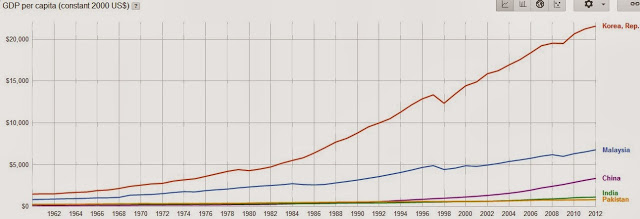
|
Per Capita GDP (Constant 2000 US$) Source: World Bank |
East and Southeast Asia:
The Asian Tigers have managed their massive growth mainly through export-driven economies that catered to the industrialized West. Each of them has built huge trade surpluses to fund their growth. These countries have invested in improving education and training to build significant human capital in a couple of decades.
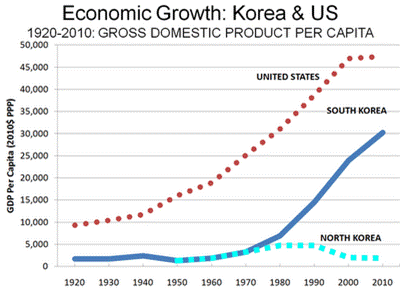
The improved productivity of the workforce, coupled with relatively low wages in Asia's developing economies, have resulted in enormous foreign investments. The large amount of foreign capital has allowed for massive growth. Their export-driven industry has spawned finance and service based industries that we now see, allowing the Tigers to maintain their high GDP. With rapid economic growth and human development, each has built a large middle class, paving the way for democracy to take root. As a result, dictatorships have given way to democracy in recent decades in most of these nations.
South Asia's Performance:
South Asia has been a laggard in economic development when compared with countries in East Asia and South East Asia . No South Asian nation has seen comparable growth in human and economic development. China, a country of 1.4 billion people run by one-party system, is far ahead of India, an equally large country run as a multi-party parliamentary democracy.
A billion people were lifted from abject poverty between 1980 and 2010. China accounts for nearly three quarters of these, or 680 million people brought out of misery, by reducing its extreme-poverty rate from 84% in 1980 to 10% now, according to a report in The Economist . The report adds that with "poorer governance in India and Africa, the next two targets, means that China’s experience is unlikely to be swiftly replicated there".
India:
As China's share of the world's extreme poor (living below $1.25 per day per person level) has dramatically declined, India's share has significantly increased . India now contributes 33% (up from 22 % in 1981). While the extreme poor in Sub-Saharan Africa represented only 11 percent of the world’s total in 1981, they now account for 34% of the world’s extreme poor, and China comes next contributing 13 percent (down from 43 percent in 1981), according to the World Bank report titled State of the Poor .
The share of poverty in South Asia region excluding India has slightly increased from 7% in 1981 to 9% now, according to the report. India now has the largest share of the world's poor, hungry, illiterate and sick who still lack access to very basic sanitation .
In a recent book "Street Smarts" , a hedge fund Manager Jim Rogers makes some important points to explain how East Asians have succeeded in developing rapidly while others have failed to do so:
"Many Asians say that the Asian Way is first to open your economy, to bring prosperity to your country, and then, only after that, to open up your political system. They say that the reason the Russians failed is that they did it the other way around. Russia opened up its political system in the absence of a sound economy, everybody bitched and complained, and chaos inevitably ensued. As an example of the Asian path to political openness, they point to South Korea and Taiwan, both of which were once vicious dictatorships supported by the United States. Japan was at one time a one-party state supported by the US military. Singapore achieved its current status under one-party authoritarian rule. All these countries have since become more prosperous and more open.
Plato, in The Republic, says that the way societies evolve is by going from dictatorship to oligarchy to democracy to chaos and back to dictatorship. It has a certain logic, and Plato was a very smart guy. I do not know if the Asians ever read The Republic, but the Asian way seems to suggest that Plato knew whereof he spoke."Not only is the Asian model different from that of the Soviets, it stands China in marked contrast to those thirty-year dictatorships previously mentioned. Chinese leaders have put a high premium upon changing the country's economy, presumably to seek prosperity for the 1.3 people who live there."
"And yet, in 1947, when it achieved independence, India was one of the more successful countries in the world, a democratic country. But despite democracy, or maybe because of it, India has never lived up to its potential. China was a shambles as recently as 1980. India was far ahead of it. But since then China has left India, literally in the dust....As China rises, India continues to decline relatively. Its debt-to-GDP ratio is now 90 percent, making a strong growth rate virtually impossible."
1960s Pakistan:
Pakistan was on a similar trajectory as the Asian Tigers during the 1960s under Gen Ayub Khan's rule. GDP growth in that decade jumped to an average annual rate of 6 percent from 3 percent in the 1950s, according to Pakistani economist Dr Ishrat Husain who says, "The manufacturing sector expanded by 9 percent annually and various new industries were set up. Agriculture grew at a respectable rate of 4 percent with the introduction of Green Revolution technology. Governance improved with a major expansion in the government’s capacity for policy analysis, design and implementation, as well as the far-reaching process of institution building. The Pakistani polity evolved from what political scientists called a 'soft state' to a 'developmental' one that had acquired the semblance of political legitimacy. By 1969, Pakistan’s manufactured exports were higher than the exports of Thailand, Malaysia and Indonesia combined ."
Bangladesh:
Some argue that it was Ayub Khan's rule in the 1960s that resulted in the loss of Pakistan's eastern wing and the creation of Bangladesh. I strongly disagree with this view. I believe that ill-conceived general elections of 1970 gave the opportunity to Pakistani politicians to lie to mostly poor and illiterate electorate of the time to win their votes. Shaikh Mujib exploited normal regional economic disparities that can be found in any country, including India and the US , to argue that Bengalis were unfairly treated. Just look at the income data for various states in the US or in India and you'll see huge gaps in incomes and standards of living. Indian Punjab's per capita income of $4,267 is almost twice of West Bengal's $2,429. New Jersey's per capita income of $53,628 is much higher than Mississippi's $33,073.
In the end, Zulfikar Ali Bhutto refused to sit down and talk with Shaikh Mujib and forced the split. Here's how one of Bhutto's friends late Gov Salman Taseer, offered his view in his book "Bhutto: A Political Biography"
"Blame can never be satisfactorily or finally apportioned to the major players in this grisly drama, but that Bhutto, Mujibur Rahman and Yahya Khan share responsibility there can be no doubt. Many, indeed, are inclined to the view that Bhutto, as the most sure-footed politician of the three and thus the best equipped to assess the consequences of his actions, must accept the lion's share of the blame. Argument on this point will remain one of the central themes of Pakistani politics, perhaps for decades."
The fact is that the economic gap between former East Pakistan and Pakistan has grown over the last 40 years, and the per capita income in Pakistan now stands at more than twice of Bangladesh's in 2012 in nominal dollar terms, higher than 1.6X in 1971.
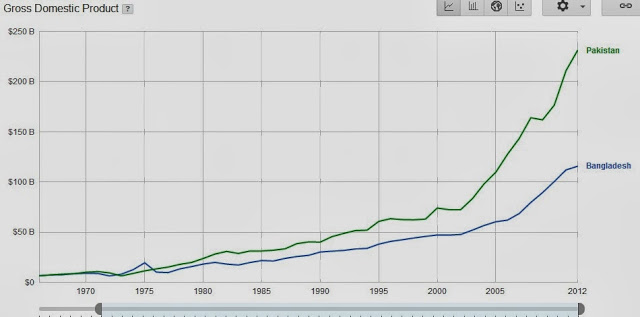
Here are some figures from Economist magazine's EIU 2013:
Bangladesh GDP per head: $695 (PPP: $1,830)
Pakistan GDP per head: $1,410 (PPP: $2,960)
Pakistan-Bangladesh GDP per head Ratio: 2.03 ( PPP: 1.62)
Pakistan's Economic History:
Since 1947, Pakistan has seen three periods of military rule: 1960s, 1980s and 2000s. In each of these decades, Pakistan's economy has performed significantly better than in decades under political governments.
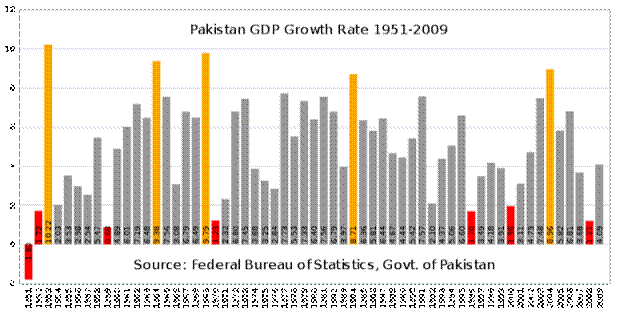
In a 10/12/1988 interview with Professor Anatol Lieven of King's College and quoted in a book "Pakistan - A Hard Country" , here is how eminent Pakistani economist Dr Mabubul Haq explained lower economic growth under "democratic" governments:
"... every time a new political government comes in they have to distribute huge amounts of state money and jobs as rewards to politicians who have supported them, and short-term populist measures to try to convince the people that their election promises meant something, which leaves nothing for long-term development. As far as development is concerned, our system has all the worst features of oligarchy and democracy put together.
That is why only technocratic, non-political governments in Pakistan have ever been able to increase revenues. But they cannot stay in power for long because they have no political support...For the same reason we have not been able to deregulate the economy as much as I wanted, despite seven years of trying, because the politicians and officials both like the system Bhutto (late Prime Minister Zulfikar Ali Bhutto) put in place. It suits them both very well, because it gave them lots of lucrative state-sponsored jobs in industry and banking to take for themselves or distribute to their relatives and supporters."
Human and Economic Development under Musharraf:
Pakistan saw yet another confirmation of accelerated economic and human development under military rule in years 2000-2007.
Pakistan's HDI grew at an average rate of 2.7% per year under President Musharraf from 2000 to 2007, and then its pace slowed to 0.7% per year in 2008 to 2012 under elected politicians, according to the 2013 Human Development Report titled “The Rise of the South: Human Progress in a Diverse World”.
At 0.515, Pakistan's HDI is lower than the average HDI value of 0.558 for South Asia which is the second lowest among the various regions of the world tracked by UNDP. Between 2000 and 2012, the region registered annual growth of 1.43% in HDI value, which is the highest of the regions. Afghanistan achieved the fastest growth (3.9%), followed by Pakistan (1.7%) and India (1.5%), according to the United Nations Development Program .
Overall, Pakistan's human development score rose by 18.9% during Musharraf years and increased just 3.4% under elected leadership since 2008. The news on the human development front got even worse in the last three years, with HDI growth slowing down as low as 0.59% — a paltry average annual increase of under 0.20 per cent.
Who's to blame for this dramatic slowdown in the nation's human development? Who gave it a low priority? Zardari? Peoples' Party? Sharif brothers? PML (N)? PML (Q)? Awami National Party? Muttahida Qaumi Movement? The answer is: All of them. They were all part of the government. In fact, the biggest share of the blame must be assigned to PML-N.
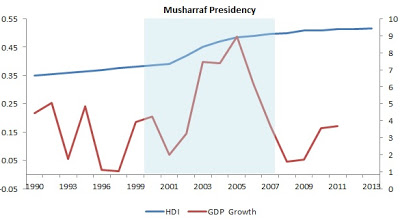
The Sharif brothers weren't part of the ruling coalition at the center. So why should the PML-N share the blame for falling growth in the nation's HDI? They must accept a large part of the blame because education and health, the biggest contributors to human development, are both provincial subjects and PML-N was responsible for education and health care of more than half of Pakistan's population.
Going further back to the decade of 1990s when the civilian leadership of the country alternated between PML (N) and PPP, the increase in Pakistan's HDI was 9.3% from 1990 to 2000, less than half of the HDI gain of 18.9% on Musharraf's watch from 2000 to 2007 .
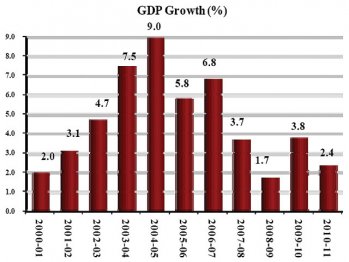
Acceleration of HDI growth during Musharraf years was not an accident. Not only did Musharraf's policies accelerate economic growth, helped create 13 million new jobs, cut poverty in half and halved the country's total debt burden in the period from 2000 to 2007, his government also ensured significant investment and focus on education and health care . In 2011, a Pakistani government commission on education found that public funding for education had been cut from 2.5% of GDP in 2007 to just 1.5% - less than the annual subsidy given to the various PSUs including Pakistan Steel and PIA, both of which continue to sustain huge losses due to patronage-based hiring .
Summary:
Looking at examples of nations such as the Asian Tigers which have achieved great success in the last few decades, the basic ingredient in each case has been large social sector investments that they have made. It will be extremely difficult for Pakistan to catch up unless similar investments are made by Pakistani leaders.
Had Pakistan's development continued on the 1960s trajectory, it is quite conceivable that Pakistan would have been a prosperous democracy like the Asian Tigers today.
------------------------------------------------------------------------------
Back to Pakistanlink Homepage

